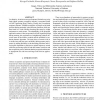500 search results - page 19 / 100 » Humans in the Process: Architectural Implications |
IJCNN
2007
IEEE
14 years 3 months ago
2007
IEEE
— Many neural network models of (human) motor learning focus on the acquisition of direct goal-to-action mappings, which results in rather inflexible motor control programs. We ...
CHI
1993
ACM
14 years 28 days ago
1993
ACM
Multimodal interaction enables the user to employ different modalities such as voice, gesture and typing for communicating with a computer. This paper presents an analysis of the ...
WIAMIS
2009
IEEE
14 years 3 months ago
2009
IEEE
An adaptive, invariant to user performance fluctuation or noisy input signal, gesture recognition scheme is presented based on Self Organizing Maps, Markov Models and Levenshtein...
AI50
2006
14 years 17 days ago
2006
"Without embodiment artificial intelligence is nothing." Algorithms in the field of artificial intelligence are mostly tested on a computer instead of testing on a real p...
VLDB
2003
ACM
14 years 9 months ago
2003
ACM
This paper describes the basic processing model and architecture of Aurora, a new system to manage data streams for monitoring applications. Monitoring applications differ substant...

